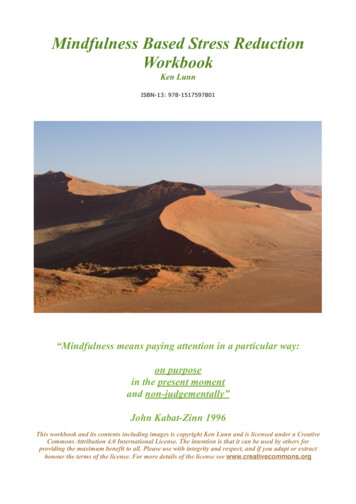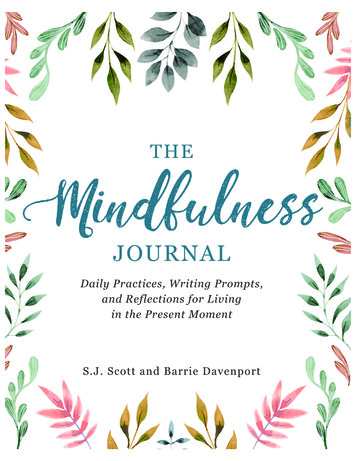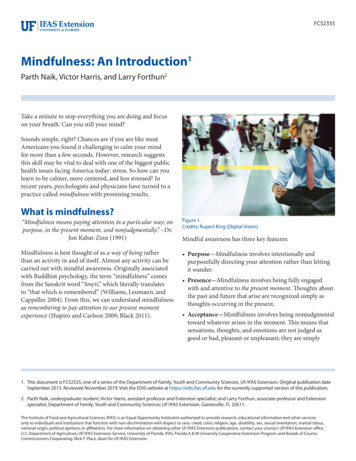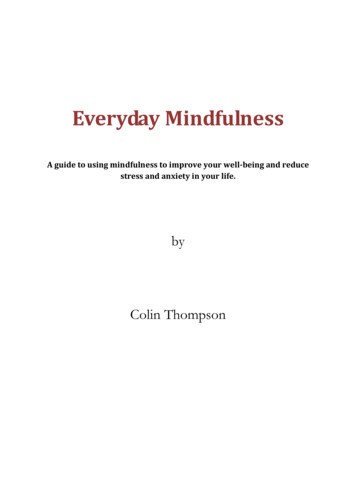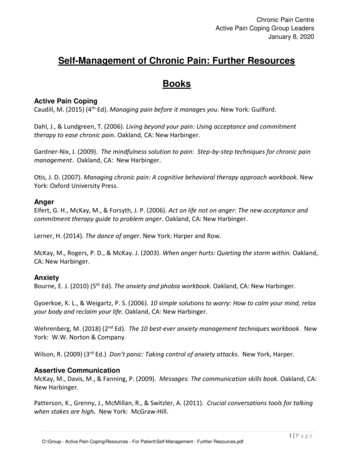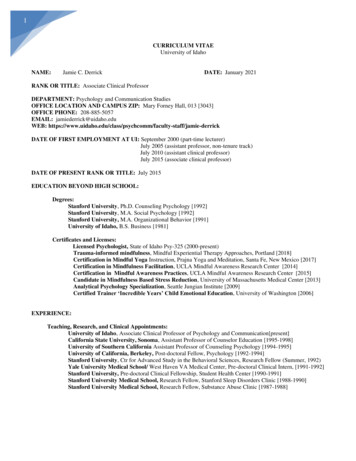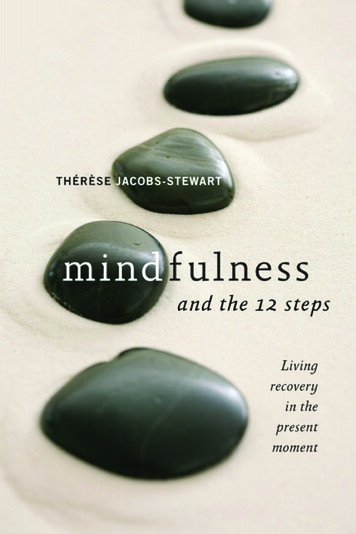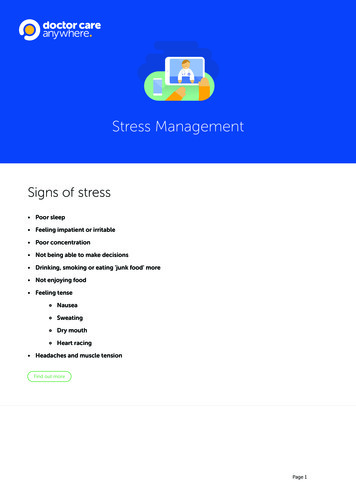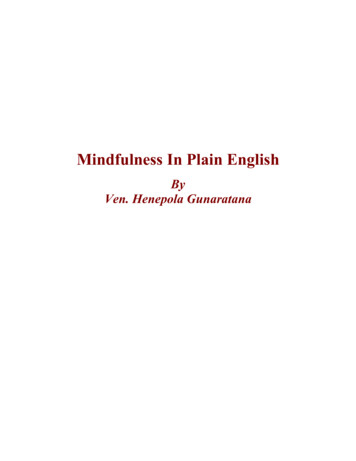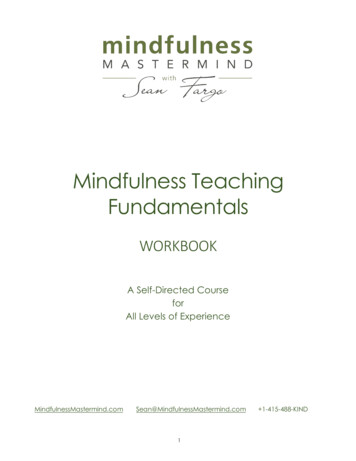
Transcription
Mindfulness TeachingFundamentalsWORKBOOKA Self-Directed CourseforAll Levels of sMastermind.com1 1-415-488-KIND
Mindfulness Teaching FundamentalsCourse IntroductionWelcome to this course Mindfulness Teaching Fundamentals.This course will provide you with an overview of key concepts and basic exercises thatare central to mindfulness practice. You will be introduced to considerations formanaging and facilitating mindfulness classes. The course will also provide you with aself-assessment tool to revisit as you begin your journey as a teacher of mindfulnessmeditation.You may find that your journey will strengthen your own personal practice.With each of your mindfulness teacher experiences, and through your reflection andself-assessment, this journey may bring you to have a more deepened insight into yourmindfulness and your embodiment of the qualities of compassion, acceptance, nonjudgement and kindness.The VoiceThere is a voice inside of youThat whispers all day long“I feel that this is right for meI know that this is wrong.”No teacher, preacher, parent, friendOr wise man can decideWhat’s right for you – just listen toThe voice that speaks inside. Shel SilversteinIn this poem Shel Silverstein acknowledges the voice within each of us to move in thedirections that are deeply personal and right at an intuitive level. Perhaps it is your voicethat brings you to this course now, at this time. May you continue to listen to the voicethat carries you on the path that is right for you.https://mindfulnessmastermind.com/2
Mindfulness Teaching FundamentalsCourse StructureThe course is comprised of 20 lessons. Each lesson will include information on thecontent area, activities and reflection questions. Each lesson has accompanyingworksheets with supplemental information, journaling, and tools for your learning.You have the freedom to proceed through the lessons at your own pace. Take notes.Take time to process your thoughts and this content, making use of the reflectionquestions. Use this course as a resource that you revisit as you select your programcurriculum and begin your practices of mindfulness and as a meditation teacher.The 20 lessons are listed:1. What is Mindfulness?*2. Research on Mindfulness3. Attitudinal Foundations*4.Four Foundations for Mindfulness Teaching5. Understanding Compassion*6. Mindfulness and Self-Compassion7. Loving-Kindness Meditation*8. Mindfulness of Breathing*9. Body Scan*10. Mindful Movement*11. Getting Started12. Common Questions13. Managing Group Processes14. Relational Skills15. Mindfulness Exercises for Teachers16. Embodiment of Mindfulness17. Guiding Meditation18. Inquiry and Didactic Teaching19. Curriculum, Pacing, Coverage20. Self-Assessment*The lessons that are starred include meditations that you will need to practice tomeet Certificate of Completion Requirements.https://mindfulnessmastermind.com/3
Mindfulness Teaching FundamentalsThis course was designed to provide you with an introduction to key concepts,exercises, and tools to develop your proficiencies as a mindfulness teacher. Theobjectives of this course are delineated. Introduce the learner to foundational concepts and definitions. Introduce basic elements to mindfulness meditation. Develop learner capacities for compassion and loving-kindness meditation. Introduce a self-assessment tool for ongoing development of teachingproficiencies. Provide strategies for planning and implementing a mindfulness course. Provide strategies for guiding and teaching meditation practice. Develop your interactive teaching skills that include relational skills and theembodiment of mindfulness.Key ResourcesThree key resources were referenced in the development of this course.It is highlyrecommended that you obtain a copy of these resources for your continued and indepth study.Christiane Wolf and J. Greg SerpaA Clinician’s Guide to Teaching Mindfulness: A Comprehensive Session-bySession Program for Mental Health Professionals and Health Care ProvidersChristopher Germer and Kristin NeffTeaching the Mindful Self-Compassion Program: A Guide for Professionalshttps://mindfulnessmastermind.com/4
Mindfulness Teaching FundamentalsThe Mindfulness-Based Teaching Assessment Criteria (MBI-TAC) thatwas developed by Crane, et. Al. Here you see the website where youmay download the document and get more information on training.The self-assessment tool provided in this course is an adaptation of theirassessment criteria, located here: https://mbsr.website/mbi-tacAcknowledgement is also given to the Greater Good Science Center out of BerkleyCalifornia.Trauma Sensitive Mindfulness by David Treleaven is a recommendedadditional resource that provides special considerations for working in asafe way with persons who have trauma,Certificate of CompletionThis course is self-paced. You are encouraged to personalize your learning experience,explore supplemental resources, deepen your practice, and apply learnings to yourteaching experiences. Expectations are that you will spend a minimum amount of timeengaged in the following course components:Viewing of Course VideosPersonal Meditation PracticeMeditation TeachingSelf-Assessment Evidence and ReviewStudy Guide/Workbook/Reflection6 5 5 3 6 hourshourshourshourshoursEligibility for the Certificate of Completion is based on the following criteria:1. Completion of the course content and workbook.2. Teaching of one mindfulness session with a rating of Competent, Proficient orAdvanced across the six domains of the Self-Assessment Tool.3. Teaching of seven identified meditations on three occasions with documentedrating of your meditation guidance competency.https://mindfulnessmastermind.com/5
Mindfulness Teaching FundamentalsThe meditation exercises you will be teaching on three occasions and rating yourcompetency as a teacher are listed:a. Mindful Eatingb. Focused Attention and Open Awarenessc. Mindfulness of Breathingd. Body Scane. Mindful Walkingf.Just Like Meg. Loving-Kindness MeditationComplete instructions begin within this document on page 85. Once you havecompleted the required documentation, you have the option to upload them to thiswebsite:https://mindfulnessmastermind.com/You may also email Sean Fargo at Sean@MindfulnessMastermind.com.Thoughts as You BeginWhether you are beginning your work as a mindfulness teacher or, perhaps, anexperienced teacher who is searching for more resources or a renewal ofunderstanding, it is the intention of this course to offer wisdom, tools, resources, andsuggestions that will support you.It takes courage to become a mindfulness teacher. You are taking on responsibilities toguide others in their personal discoveries. You are exposing your authentic self.As you begin this journey, be kind to yourself.“As you start to walk out on the way, the way appears.” RumiYou are invited to ask questions, enter discussions, and dialogue on the MindfulnessExercises.com Forum. You will find the forum at this link:https://mindfulnessmastermind.com/6
Mindfulness Teaching ommunity/You may also find additional resources on mindfulness at my website,https://mindfulnessmastermind.com/I am honored you have chosen to learn more about gratitude and to deepen yourpractice.Thank you.Sean Fargo, mastermind.com/7
Mindfulness Teaching FundamentalsTable of ContentsPageLesson 1: What Is Mindfulness?9Lesson 2: Research on Mindfulness12Lesson 3: Attitudinal Foundations16Lesson 4: Four Foundations of Mindfulness Teaching20Lesson 5: Understanding Compassion23Lesson 6: Mindfulness of Self-Compassion27Lesson 7: Loving-Kindness Meditation32Lesson 8: Mindfulness of Breathing35Lesson 9: Body Scan38Lesson 10: Mindful Movement41Lesson 11: Getting Started44Lesson 12: Common Questions50Lesson 13: Group Processes52Lesson 14: Relational Skills56Lesson 15: Mindfulness Exercises for Teachers60Lesson 16: Embodiment of Mindfulness64Lesson 17: Guiding Meditation67Lesson 18: Inquiry and Didactic Teaching70Lesson 19: Curriculum, Pacing, Coverage75Lesson 20: Self-Assessment77Instructions Application for Certificate of Completion85Mindfulness Teaching Self-Assessment Rubric87Meditation Guidance Rating Form88List of om/8
Mindfulness Teaching FundamentalsLESSON 1: WHAT IS MINDFULNESS?As you begin this lesson, “What is Mindfulness?”, pause to consider your understandingof mindfulness. What is your personal definition of mindfulness?“Mindfulness is non-judgmental awareness of your moment-to-moment experience.”(Sean Fargo)“Mindfulness is awareness, cultivated by paying attention in a sustained and particularway: on purpose, in the present moment, and nonjudgmentally to the unfolding ofexperience moment by moment.” (Jon Kabat-Zinn, 2003)“The first component of mindfulness involves the self-regulation of attention so that it ismaintained on immediate experience, thereby allowing for increased recognition ofmental events in the present moment. The second component involves adopting aparticular orientation toward one’s experience in the present moment, an orientationthat is characterized by curiosity, openness, and acceptance.” (Scott Bishop, et. al,2004)Pause to consider how these definitions compare to your own understanding.When you consider your role as a mindfulness teacher, how might you unpack thesedefinitions for your students?https://mindfulnessmastermind.com/9
Mindfulness Teaching FundamentalsThere are three types of mindfulness meditation:1. Focused attention, which is the practice of returning concentration to again andagain to one object, such as breath. The focused concentration helps to calmthe mind;2. Open monitoring, which is paying attention to what comes to mind from onemoment to the next, and;3. Loving kindness and compassion meditation, which cultivates warmth andgoodwill toward oneself and others.To understand mindfulness, think of it as a practice of “sensing” instead of “fixing”.When we fail to be mindful in our thoughts and actions, there are consequences. Listthe potential negative consequences that may arise when we are not mindful.View the video, “The Raisin Experience”. This video is located at this link:https://www.youtube.com/watch?v 5YkjoXuCfWYReflection QuestionsWhat did you observe as you engaged in the Eating a Raisin Exercise?https://mindfulnessmastermind.com/10
Mindfulness Teaching FundamentalsRevisit your beginning working definition of mindfulness. Has it shifted? Refine it here:What questions do you anticipate from your students?Mindful Practice and Teaching ExerciseLet us take the practice of mindful eating deeper with the exercises that are located inthe appendix. You will find two exercises: Eating Mindfully and Eating Meditation. Tryeach in your own practice. Select the one you prefer to use in your teaching.If you are seeking a Certificate of Completion, you will teach the exercise on threeoccasions. Refer to the Self-Assessment Tool and collect evidence of your teaching ofthe exercise.Supplemental ActivityLearning to practice Mindfulness does not have to be difficult. Rather, it can be amatter of carving out the time. In this Ted Talk Andy Puddicombe explains how a 10minute meditation can be accomplished.https://www.youtube.com/watch?v qzR62JJCMBQWhat is your take away from this video?https://mindfulnessmastermind.com/11
Mindfulness Teaching FundamentalsLESSON 2: RESEARCH ON MINDFULNESSThere is a plethora of research on the efficacy of mindfulness meditation. Crossdisciplinary studies are examining the mechanisms by which the simple behavior offocused attention with kindness will positively influence the feelings, cognition,neurology, and biology of the individual, leading to improvements in mental health,outlook, coping, and health.Take notes from the course video on the research in each of the three categories ofstudy:Symptom ReductionBiological d.com/12
Mindfulness Teaching FundamentalsSummary of what we are learning from the mindfulness research:1. The quality of research on mindfulness has improved with moderate to strongpositive effects.2. Research has expanded to examine symptom reports, biomedical markers,neuroplasticity, and experience of self-compassion.3. With training in mindfulness meditation, benefits have been noted in workingmemory, cognition, reduced stress, lessened anxiety and depression, andresponse to illness.4. Mindfulness meditation has been linked to stronger immunity, reduction inmarkers of inflammation in the body, and stronger neural connections in thebrain.5. The practice of mindfulness increases the experience of self-compassion,compassion toward others and improved relationship to others.Your continued familiarity with the research will increase your effectiveness as apractitioner and teacher of mindfulness.Reflection QuestionsWhat questions do you have that may be addressed through research?How will you integrate your understanding of research into your teaching?https://mindfulnessmastermind.com/13
Mindfulness Teaching FundamentalsSupplemental ActivitiesThe Science Behind Mindfulness VideoSupplement your understanding with this video that provides an illustrated explanationof how mindfulness is good for the brain.https://www.youtube.com/watch?v VTA0j8FfCvsWhat is your take-away?Stay current by continuing your study of the research on mindfulness that is the best fitfor your context. Here is a brief list to get you started: Center for Mindfulness and Human Potential. Department of Psychological andBrain Sciences, University of California, Santa Barbarahttps://www.cmhp.ucsb.edu/ Center for Mindfulness in Medicine, Health Care, and Society at the University ofMassachusetts Medical Schoolhttps://www.umassmed.edu/cfm/ Curry School of Education, University of Virginiahttps://curry.virginia.edu/ Go American Mindfulness Research Association. Pasadena, California.https://goamra.org/ Greater Good Science Center. University of California - Berkeleyhttps://greatergood.berkeley.edu/ School of Human Ecology and the Center for Healthy Minds, University ofWisconsin-Madisonhttps://centerhealthyminds.org/ University of Oxford Research esshttps://mindfulnessmastermind.com/14
Mindfulness Teaching FundamentalsWhat habits of study will you develop to stay informed on current research findings inyour role as a teacher of mindfulness?https://mindfulnessmastermind.com/15
Mindfulness Teaching FundamentalsLESSON 3: ATTITUDINAL FOUNDATIONSJon Kabat-Zinn has identified attitudes that are foundational to mindfulness. Take notesas you review the course video and the video of Jon Kabat-Zinn explaining theattitudes that are foundational to mindfulness practice.Video of Jon Kabat-Zinnhttps://www.youtube.com/watch?v 2n7FOBFMvXgBeginner’s Mind“In the beginner’s mind there are many possibilities, in the experts’ mind there are few”. Suzuki RoshiAcceptance“Life is a series of natural and spontaneous changes. Don't resist them; that only createssorrow. Let reality be reality. Let things flow naturally forward in whatever way they like.” Lao TzuNon-Judging“Only a non-judgmental mind has intelligence, because it is spontaneously respondingto reality.” RajneeshNon-Striving“Non-striving is trying less and being more.” Jon Kabat-Zinnhttps://mindfulnessmastermind.com/16
Mindfulness Teaching FundamentalsLetting Go/Letting Be“Seek not that the things which happen should happen as you wish, but wish the thingswhich happen to be as they are, and you will have a tranquil flow in life.” EpictetusPatience“Patience is the calm acceptance that things can happen in a different order thanthe one you have in your mind.” David G. AllenTrust“Trust your inner know” Daren MartinGratitude“Gratitude unlocks the fullness of life. It turns what we have into enough, and more. Itturns denial into acceptance, chaos to order, confusion to clarity. “ Melody Beattiehttps://mindfulnessmastermind.com/17
Mindfulness Teaching FundamentalsHow will you teach these foundational attitudes?Review the course video again and fill in this chart with ideas for how you will modelthese attitudinal foundations to mindfulness.AttitudeTeaching StrategyBeginner’s MindAcceptanceNon-JudgingNon- StrivingLetting Go/Letting ind.com/18
Mindfulness Teaching FundamentalsFocused Attention and Open Awareness MeditationGo to Mindfulness Exercises.com to the guided meditation for Focused Attention andOpen Awareness. Review the transcript and worksheet on the website. You will alsofind this exercise in the ay-25-focused-attention-open-awareness/Observe and journal your experience.If you are seeking a Certificate of Completion, you will need to log your personalmeditation practice plus teach this meditation on three occasions.Supplemental ActivityPractice Breath Exercises Over TimeAs you develop the depth of your experience with mindfulness, you will become abetter teacher of others. Build your practice and understanding of the attitudinalfoundations with the breath. The breath is a powerful place to begin in experiencingthe attitudes of mindfulness. Visit the 6 Mindful Breathing Exercises at MindfulnessExercises.com. As you engage in mindful breathing, reflect on how you connect yourbreath to your understanding of the attitudes that are foundational to a heartful andmindful ind.com/19
Mindfulness Teaching FundamentalsLESSON 4: FOUR FOUNDATIONS OF MINDFULNESS TEACHINGThere are four foundations of mindfulness teaching. They are listed: Mindfulness of the BodyMindfulness of the Feeling TonesMindfulness of the MindMindfulness of How the Mind OperatesEach will be explored in more detail in the video course and with the supplementalresources of this study guide. Take the time to view each of the videos and take notes,recording your new learnings and insights.Mindfulness of the BodyMindfulness of the body is the starting point and anchor to the present moment.This video, narrated by Jon Kabat-Zinn, is a guided exercise of the body scan.https://www.youtube.com/watch?v 15q-N- kkrU&feature youtu.beNotes:Mindfulness of the Feeling TonesBy being mindful of the body, all experience can be categorized as pleasant,unpleasant or neutral. Feeling tones accompany emotions.In this video, Dr. Jamie March takes you through a guided exercise in Mindfulness ofFeeling Tone. https://www.youtube.com/watch?v /20
Mindfulness Teaching FundamentalsMindfulness of the MindAs you explore mindfulness of the mind, view this video, What Is the Stream tream-of-consciousness/Notes:Mindfulness of How the Mind OperatesIn observing how the mind operates, one becomes aware of the forms of existence,virtues, or enlightenment are manifest.In this video Eckhart Tolle discusses the state of cept-of-enlightenment/Notes:Ethics: The Five PreceptsThere are 5 ethical guidelines that are foundational to developing safety for oneselfand your students. Not killing or harming Not stealing Not harming anybody, including oneself, with sexuality or strong desires Not lying Not intoxicating the mind with anything that leads to addictionhttps://mindfulnessmastermind.com/21
Mindfulness Teaching FundamentalsYou also have professional ethics or a code of conduct. The ethics to who you are andhow you conduct yourself are the foundation of your authenticity as a facilitator to thelearning of others.Reflection QuestionsAs you practice mindfulness exercise, what are you noticing in the working of yourmind? What are the shifts within your practice?As you work with others, how might awareness of the feeling tones be healing andtransformative for them?How do your personal and professional ethics shape your mindful choices?https://mindfulnessmastermind.com/22
Mindfulness Teaching FundamentalsLESSON 5: UNDERSTANDING COMPASSIONAs we begin this lesson on compassion, pause to consider this quotation:“Compassion is the basis of morality.” Arthur SchopenhauerThoughts:Consider the times in which someone showed compassion to you. How did you feel?What values of compassion do you hold toward others? Society?What questions do you have about the topic of compassion and its connection tomindfulness practice?https://mindfulnessmastermind.com/23
Mindfulness Teaching FundamentalsCompassion is the desire to relieve suffering. It is a capacity that is deeply human.Compassion is a core and universal emotion. It is believed that the capacity forcompassion extends from our innate biologically driven protection of the young.Mindfulness cultivates presence and simplifies things to help us to embody who wealready are. Even Albert Einstein pondered the importance of compassion to humanityin his words,“Our task must be to free ourselves by widening our circle of compassion to embraceall living creatures and the whole of nature and its beauty.” Albert EinsteinThoughts:How might we understand compassion and mindfulness?Mindfulness gives us the space to let go, to explore and to embrace a widenedexperience that is shared by others. Jon Kabat-Zinn explains compassion andmindfulness in this interview:Jon Kabat-Zinn Mindfulness and Compassionhttps://www.youtube.com/watch?v l7E7FBSlB1UNotes from video:https://mindfulnessmastermind.com/24
Mindfulness Teaching FundamentalsResearch has confirmed that meditation leads us to experience and express morecompassion toward others.The Qualities of CompassionConsider how you may invite these qualities into your interactions with others in yourdaily life and in your teaching.Curiosity - genuine interest in what a student is experiencingKindness - a hospitable, non-judging attitudeWarmth - a tender inclination of heart toward the individualRespect - appreciating the uniqueness of each individualAllowing - not fixing and allowing each person to be whole and complete nowHumility - assuming that one person doesn’t know what is best for anotherMutuality - sense of commonality with others in struggles and aspirationsCuriosity - genuine interest in what a student is experiencingKindness - a hospitable, non-judging attitudeWarmth - a tender inclination of heart toward the individualRespect - appreciating the uniqueness of each individualAllowing - not fixing and allowing each person to be whole and complete nowGenerosity - willingness to go beyond one’s usual limitationsAttentiveness - ability to focus on the experience of anotherEmpathy - feeling another’s world as one’s ownEquanimity - perspective and steadiness in the midst of strong emotionsWisdom - understanding complexity and seeing a way throughConfidence - inner strength that arises from goodwillHumility - assuming that one person doesn’t know what is best for 25
Mindfulness Teaching FundamentalsJust Like Me MeditationGo to Mindfulness Exercises.com to the guided meditation, Just Like just-like-me/You will also find this meditation in the Appendix section of resources. Record yourobservations of your feelings and how they may have shifted through this exercise.Record your observations of your feelings and how they may have shifted through thisexercise.If you are seeking a Certificate of Completion, you will need to log your practice theJust Like Me exercise plus guide another on three occasions. Use the self-assessmenttool to record evidence of your progress in teaching the meditation.Reflection QuestionsReflect upon the list of compassion qualities. Begin your exploration of compassion byselecting 1 - 3 qualities that you intentionally plan to cultivate in your mindfulnesspractice and teaching.Consider the capacity of our shared humanity that is expanded through mindfulmeditation. What are your insights and inspirations?https://mindfulnessmastermind.com/26
Mindfulness Teaching FundamentalsLESSON 6: MINDFULNESS AND SELF-COMPASSIONBegin by considering these words:“If your compassion does not include yourself, it is incomplete.” Jack KornfieldReflect on the ways you extend compassion to yourself or perhaps how you learned todevelop compassion toward yourself.Consider the students you will be teaching. Many will come to you with physical pain orpersonal stressors and challenges. You may be working in a clinical situation withpersons who are overcoming anxiety or depression. What are your questions about theplace for self-compassion in their learning and recovery?Understanding Self-Compassion and MindfulnessMindfulness has been described as a loving awareness of experience.Self-compassion is a loving awareness of the experiencer. Self-compassion isunconditional self-acceptance even in moments of failure.https://mindfulnessmastermind.com/27
Mindfulness Teaching FundamentalsResearch is demonstrating that self-compassion can help to mitigate the effects oftrauma in childhood. Components of the stress response to trauma include self-criticism,self-isolation and self-absorption. Intervention with self-compassion approaches mayhelp individuals to have improved coping to upsetting events. (Germer and Neff, 2014)To address questions that might arise as to what self-compassion is and is not, view thisvideo with Kristen Neff:https://www.youtube.com/watch?v YFhcNPjIMjcNotes:This table summarizes what self-compassion is and is not.Self-Compassion IS NOT.Self-Compassion IS.selfish or self-centered.emotional resources to care for others.a form of self-pity.opening to see the interconnected experiences ofself and others without exaggeration.weak.potentially self-protective and self-supporting; asource of strength and resilience in challengingsituations.self-indulgent.aimed at the alleviation of suffering, choosing longterm well-being over short-term pleasure.harsh, belittling selfjudgment.constructive criticism and discernment.fear and shame thatundermine motivation.enhances motivation with care, support andencouragementAdapted from Germer and Neff, p. 30https://mindfulnessmastermind.com/28
Mindfulness Teaching FundamentalsHow might you use these distinctions in your teaching?Research FindingsSelf-compassion is linked to: Reduced negative states such as depression, anxiety, and shame Increased positive states like happiness and life satisfaction Fewer problems related to striving for self-esteem Healthier body image and less disordered eating behaviors Reduced risk of caregiver burnout Better physical health and immune function Improvements in coping for persons who experienced trauma For persons with clinical disorders who tend to have less self-compassion,increased self-compassion appears to be an important mechanism of change intherapy (Germer and Neff, p.56)Becoming a Teacher of Self-CompassionA teacher models self-compassion through “loving, connected presence”.What is your vision or understanding of a “loving, connected presence”?Your self-compassion is embodied by what you say, how you relate to others and the climate or atmosphere you create in your class.https://mindfulnessmastermind.com/29
Mindfulness Teaching FundamentalsCultural AwarenessA critical aspect to your embodiment of self-compassion is found in your culturalawareness and sensitivity.Develop your capacity to embrace diversity and seek for expanded understanding ofcultural identities and their accompanying feelings.“Expanding our sensitivity to the impact of culture in our lives, especially the impact onthose who are subject to daily injury within a particular culture, is an important gatewayto living and teaching more compassionately.” Germer and Neff (p118)Thoughts?Self-Love MeditationRefer to the appendix of this course with the meditation scripts to locate the LovingKindness of Self Meditation script. Use this script in your own practice.If you are seeking a Certificate of Completion, you will need to teach this meditation onthree occasions and provide evidence using the self-assessment tool.Journal your experience with self-compassion meditation.https://mindfulnessmastermind.com/30
Mindfulness Teaching FundamentalsReflection QuestionsHow does self-compassion strengthen us to explore our capacities?How might you demonstrate mindful compassion as a teacher?Take a few minutes to journal your thoughts and feelings about your cultural experienceand identity for 20 days. Read and reflect on what you are uncovering and where youmay focus your attention to increase your cultural sensitivity.Recommended Curriculum and ReadingGermer and Neff, Teaching the Mindful Self-Compassion Program. 2019. The GuilfordPress.https://mindfulnessmastermind.com/31
Mindfulness Teaching FundamentalsLESSON 7: LOVING-KINDNESS MEDITATIONIn Loving-Kindness Meditation, one is guided, through imagery, words or phrases toextend positive thoughts to others and the self. Loving-kindness meditation cultivatesfeelings of compassion, equanimity and gratitude.Research Benefits Increase in positive emotionsQuieting of negative emotionsStrengthened capacity for empathyMigraine sufferers experience lessened painIncreased compassionBiological changes associated with longer lifeThe Metta PrayerTake a few moments to pause, breathe deeply and repeat the Metta prayer. Repeatthe prayer daily for two weeks. What comes to you? Do you notice shifts in your feelingsof compassion?The Metta PrayerMay all beings be safe.May all beings be healthy.May all beings be happy.May all beings live with ease.May I be safe.May I be healthy.May I be happy.May I live with ease.
Introduce a self-assessment tool for ongoing development of teaching proficiencies. Provide strategies for planning and implementing a mindfulness course. Provide strategies for guiding and teaching meditation practice. Develop your interactive teaching skills that inc
